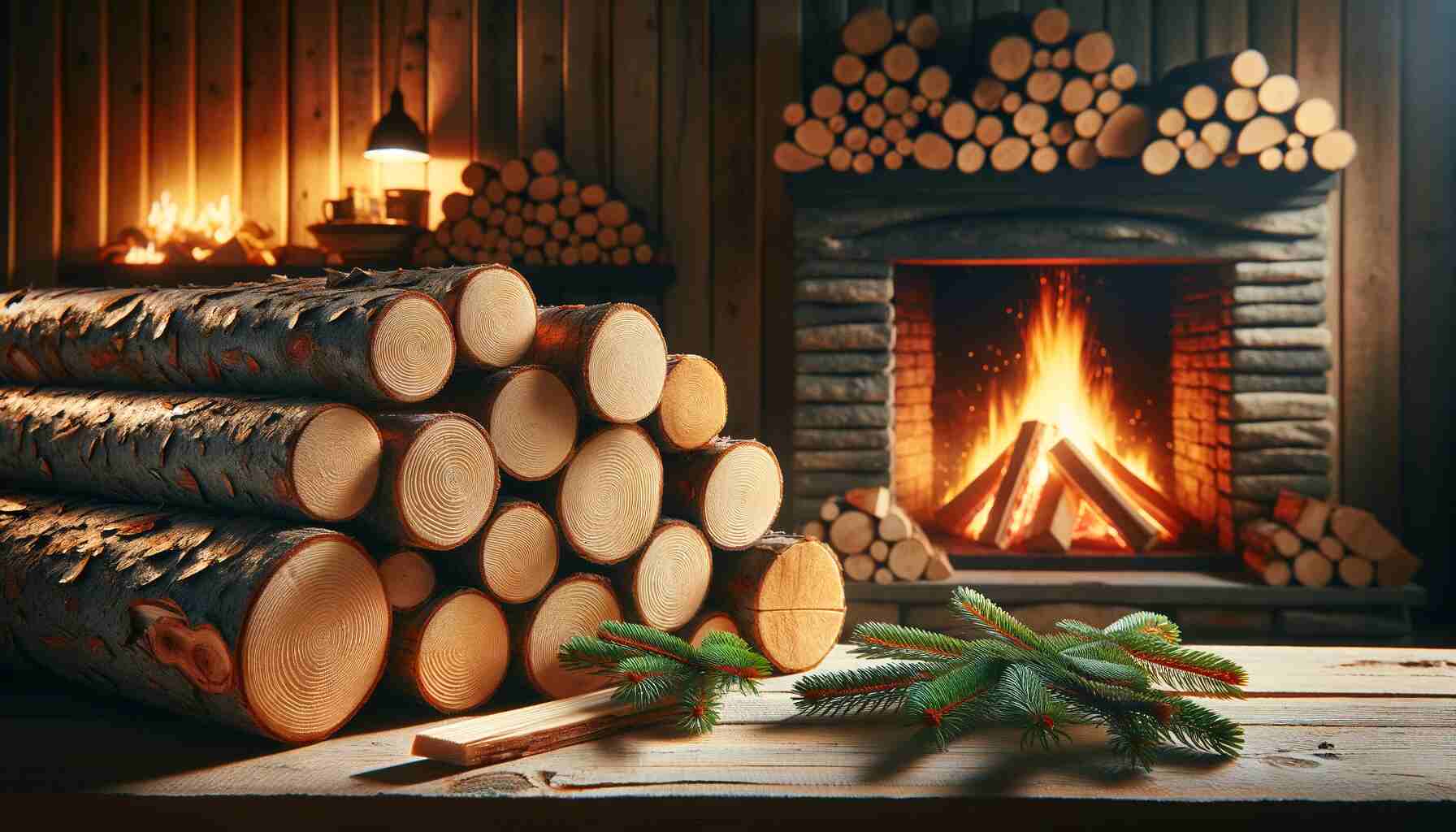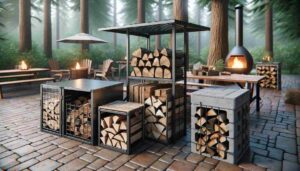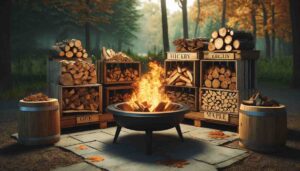When it comes to firewood, spruce is a popular choice for many homeowners and outdoor enthusiasts. Spruce firewood is known for its ease of splitting, quick seasoning time, and pleasant aroma. In this comprehensive guide, we will delve deep into everything you need to know about spruce firewood, including the various types of spruce wood, its benefits, burning characteristics, BTU values, where to find it for sale, and tips for efficient burning.
Spruce Firewood
Spruce is a type of softwood tree that belongs to the pine family (Pinaceae). It is commonly found in North America, Europe, and Asia and is prized for its versatility and availability. The wood of the spruce tree is a popular choice for firewood due to its excellent burning qualities.
Spruce firewood is favored for several reasons:
- Quick Seasoning: Spruce wood has a relatively low moisture content, which means it dries and seasons faster than some other hardwoods. This makes it a convenient choice for those who need firewood in a hurry.
- Easy to Split: The wood is relatively soft and easy to split, making it accessible to those without heavy-duty equipment. It’s ideal for splitting by hand or with basic tools.
- Aromatic: Burning spruce wood releases a pleasant, piney aroma that many people find appealing. This can enhance the ambiance of your indoor fireplace or outdoor campfire.
- Clean Burning: Spruce firewood tends to burn cleanly with minimal creosote buildup in chimneys or stovepipes, reducing the risk of chimney fires.
Now, let’s explore the various types of spruce wood you may encounter for burning.
Types of Spruce Wood
a. Black Spruce Firewood
Black spruce (Picea mariana) is a common spruce variety found in North America, especially in northern regions. It is known for its adaptability to cold climates and can be found in various environments, including swamps and boreal forests. Black spruce firewood is readily available in these regions and is valued for its heat-producing qualities.
b. Blue Spruce Firewood
Blue spruce (Picea pungens) is renowned for its striking bluish-gray needles. While it is primarily grown as an ornamental tree, some homeowners use blue spruce firewood for its unique appearance and pleasant aroma. It may not be as common for firewood as other spruce species, but it can still be a viable option if available.
c. Norway Spruce Firewood
Norway spruce (Picea abies) is one of the most widely distributed spruce species in Europe. It is also grown in North America and is a popular choice for Christmas trees. Norway spruce firewood burns well, producing a good amount of heat. It’s often readily available in regions where the tree is cultivated.
d. Sitka Spruce Firewood
Sitka spruce (Picea sitchensis) is primarily found along the Pacific coast of North America, from Alaska to California. It is one of the largest species of spruce and is used for various purposes, including musical instruments and boatbuilding. Sitka spruce firewood is prized for its high BTU output and efficient burning.
e. Spruce Tree Firewood
In some cases, people may use firewood from various types of spruce trees without specifying a particular species. The suitability of spruce tree firewood can vary depending on the specific type of spruce, but in general, spruce wood tends to have favorable burning characteristics.
Now that you’re familiar with some of the common types of spruce wood, let’s explore the benefits of using spruce firewood.
Benefits of Using Spruce Firewood
Using spruce firewood offers several advantages for both indoor heating and outdoor recreational purposes:
- Rapid Seasoning: Spruce wood typically has a lower moisture content than many hardwoods, allowing it to season quickly. This means you can start using it for heating or cooking sooner after cutting and splitting.
- Easy to Split: The soft nature of spruce wood makes it easy to split, even without heavy machinery. This is great for those who want to split their firewood by hand or with minimal equipment.
- Aromatic Experience: The pleasant piney aroma released when burning spruce wood can enhance the atmosphere of your living space or campsite. It provides a natural and appealing fragrance that many find enjoyable.
- Clean Burning: Spruce firewood tends to burn cleanly with minimal creosote buildup in chimneys or stovepipes. This reduces the risk of chimney fires and makes maintenance easier.
- Sustainability: When sourced responsibly, spruce firewood can be an environmentally friendly choice. Many regions have sustainable forestry practices in place to ensure a continuous supply of spruce wood.
- High BTU Output: Despite being a softwood, spruce can produce a respectable amount of heat. Its BTU (British Thermal Unit) value is competitive with many hardwoods, making it an efficient choice for heating.
- Availability: Depending on your location, spruce firewood may be readily available, which can be convenient for those looking for a local and affordable heating option.
Now that you know the benefits of using spruce firewood, let’s dive into what to expect when burning spruce wood.
Burning Spruce Wood: What to Expect
Burning spruce wood can be a rewarding experience, but it’s essential to understand its burning characteristics to achieve the best results. Here’s what you can expect when burning spruce wood:
- Quick Ignition: Spruce wood ignites relatively easily, making it convenient for starting fires in stoves, fireplaces, or outdoor fire pits. You won’t need to use excessive kindling or fire starters to get it going.
- Flame Intensity: Spruce wood tends to produce a lively flame with a bright, cheerful appearance. This can add to the ambiance of your indoor or outdoor fire.
- Crackling Sounds: The sap content in spruce wood can lead to occasional crackling or popping sounds as it burns. Some people find this sound charming, while others may need to adjust to it.
- Pleasant Aroma: The aroma of burning spruce wood is often described as piney and refreshing. It can fill your space with a natural fragrance that many people enjoy.
- Moderate Heat Output: While spruce wood can generate a decent amount of heat, it may not be as dense as hardwoods, resulting in a slightly lower heat output. However, it can still provide ample warmth for heating a room or cooking.
- Ash Production: Spruce wood tends to produce a relatively low amount of ash when burned. This means less frequent ash removal and less maintenance for your stove or fireplace.
- Resin and Creosote: Some spruce species contain resin, which can lead to creosote buildup in your chimney or stovepipe. To minimize this risk, it’s essential to burn well-seasoned spruce wood and ensure proper airflow.
- Efficiency: To maximize the efficiency of burning spruce wood, use well-dried and seasoned logs. It’s also advisable to mix spruce wood with other hardwoods for a more extended, controlled burn and increased heat output.
Understanding how spruce wood burns will help you make the most of this versatile firewood. To determine its heating potential, let’s explore BTU values.
Understanding BTU Values
BTU (British Thermal Unit) is a unit of measurement used to quantify the heat energy produced by burning a specific type of fuel, including firewood. Understanding the BTU value of spruce firewood can help you gauge its heating efficiency and compare it to other types of wood.
The BTU value of spruce firewood can vary depending on factors such as the specific species, moisture content, and overall wood quality. However, on average, spruce firewood has a BTU value of approximately 15 to 20 million BTUs per cord. This places it in the mid-range of heat-producing firewood, similar to other softwoods like pine.
To maximize the heat output of spruce firewood, it’s essential to ensure it is well-seasoned, with a moisture content of around 20% or less. Properly dried spruce wood will burn more efficiently, producing consistent heat and minimal smoke.
Where to Find Spruce Firewood for Sale
If you’re interested in using spruce firewood for heating or recreational fires, you can typically find it for sale through various sources. Here are some common places to look for spruce firewood:
- Local Firewood Suppliers: Many local firewood suppliers offer spruce firewood as part of their product range. These suppliers often provide well-seasoned firewood in various quantities, from bundles to full cords.
- Online Marketplaces: You can find spruce firewood for sale on online marketplaces such as Craigslist, Facebook Marketplace, and specialized firewood selling websites. Be sure to verify the quality and seasoning of the wood before purchasing.
- Forestry and Logging Companies: Some forestry and logging companies may sell spruce firewood as a byproduct of their operations. Contact them directly to inquire about availability.
- Home and Garden Stores: In areas where spruce is prevalent, home and garden stores may carry spruce firewood for sale, especially during the colder months.
- Local Classified Ads: Check local classified ads in newspapers or online platforms for individuals selling firewood, including spruce.
When purchasing spruce firewood, it’s essential to inquire about the moisture content, as well-seasoned wood burns more efficiently and cleanly. Additionally, ask about delivery options if needed, as firewood can be bulky and challenging to transport.
Tips for Efficiently Burning Spruce Firewood
To make the most of your spruce firewood and ensure a safe and efficient burning experience, consider the following tips:
- Season the Wood: Properly season your spruce firewood by allowing it to dry for at least six months to a year. This reduces moisture content and improves combustion efficiency.
- Store Firewood Properly: Store your firewood off the ground and in a well-ventilated area to prevent moisture absorption. Use a firewood rack or pallets to elevate the wood and allow air circulation.
- Mix with Hardwoods: Consider mixing spruce wood with hardwoods like oak, maple, or hickory. Hardwoods burn hotter and longer, complementing the moderate heat output of spruce.
- Use Adequate Kindling: Ensure you have enough kindling to start your fire easily. Small twigs, newspaper, or fire starters can help ignite the spruce wood quickly.
- Maintain Proper Airflow: Adequate airflow is crucial for efficient combustion and reducing creosote buildup. Follow the manufacturer’s recommendations for your stove or fireplace, and clean your chimney regularly.
- Safety First: Always prioritize safety when handling firewood and operating heating appliances. Install and maintain smoke detectors, carbon monoxide detectors, and fire extinguishers in your home.
- Follow Local Regulations: Be aware of local regulations regarding firewood burning, especially in areas prone to air quality issues. Some regions have restrictions on the types of wood that can be burned and when.
- Consider a Moisture Meter: Invest in a moisture meter to measure the moisture content of your firewood accurately. This tool can help you determine when your wood is ready for burning.
- Inspect Your Chimney: Have your chimney and stove or fireplace inspected regularly by a professional to ensure they are in good working condition and free from obstructions.
Conclusion
Spruce firewood is a versatile and accessible choice for heating and recreational fires. Its quick seasoning time, ease of splitting, pleasant aroma, and moderate heat output make it a popular option for many homeowners and outdoor enthusiasts.
Understanding the various types of spruce wood, its benefits, burning characteristics, BTU values, and where to find it for sale can help you make an informed decision about using spruce firewood. Additionally, following the provided tips for efficient burning will ensure a safe and enjoyable experience as you harness the warmth and ambiance of this fantastic firewood. Whether you’re cozying up by the indoor fireplace or gathering around a campfire in the great outdoors, spruce firewood is an excellent choice for all your fire-related needs.










